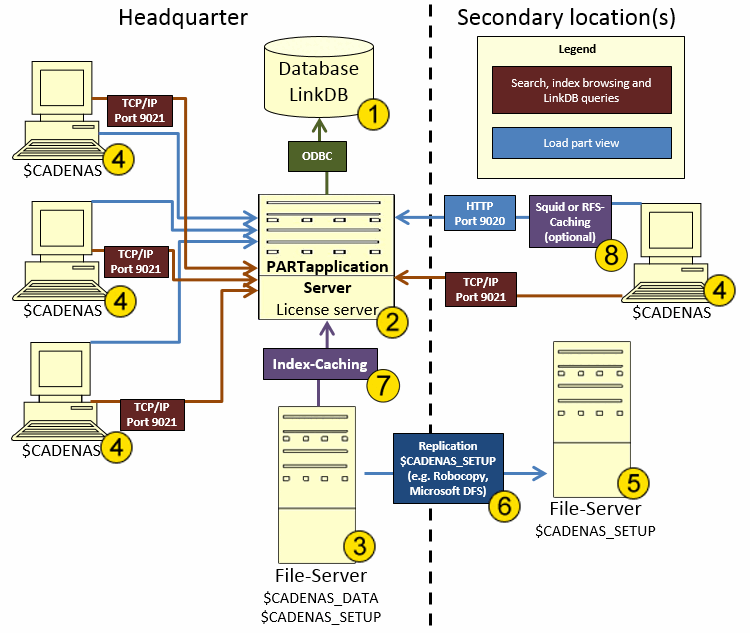The following figure shows the recommended architecture with a Multi Site Installation.
In the following explanations and further links analogously to the individual components and processes of the figure are found:

|
The 3Dfindit link database (LinkDB) is set up as a new database on an existing database server. No new software is required on the database server. Detailed information is found under Section 4.2, “Installation Link database ”. |

|
A separate server or virtual machine is recommended for the PARTapplicationServer.
ONE central PARTapplicationServer for all locations is sufficient. All clients obtain the detailed data of the search hits from a central $CADENAS_DATA file server. It makes sense to also install the CADENAS license service on this server. See FLM server installation - Requesting/installing licenses. |

|
For the CADENAS catalogs and the setup directory, a new release on an existing file server is sufficient. No new software is required on the file server.
|

|
$CADENAS on clients (3Dfindit software and interfaces) Software distribution / software updates In complex installation environments, it is advisable to set up an admin client and copy it using the company's standard software distribution tools.Advantage: Software updates can be carried out just as easily later. |

|
File-Server Secondary Location (Setup directory [$CADENAS_SETUP]) |

|
$CADENAS_SETUP can easily be replicated (cyclically or if needed) from the head quarter to the secondary locations (e.g. with Robocopy, Microsoft DFS or similar tools). |

|
In order for the PARTapplicationServer to work efficiently, we recommend caching the CADENAS_DATA index files. Detailed information on this is found under Section 1.4.5.8.1.8, “ Caching index files of $CADENAS_DATA on PARTapplicationServer ” and Section 1.4.5.4, “Caching methods for data storage and operation ”. |

|
RFS or SQUID Caching (optionally) In order for the data flow between client and server to be optimal, often used data (especially project and ZJV files) can be cached. At large assemblies (also at native parts) in this way the performance can be enhanced. See Section 1.4.5.8.2.4, “Caching on client side or at secondary locations ” and Section 1.4.5.4, “Caching methods for data storage and operation ”. |



![[Note]](https://webapi.partcommunity.com/service/help/latest/pages/jp/3dfindit/doc/images/note.png)